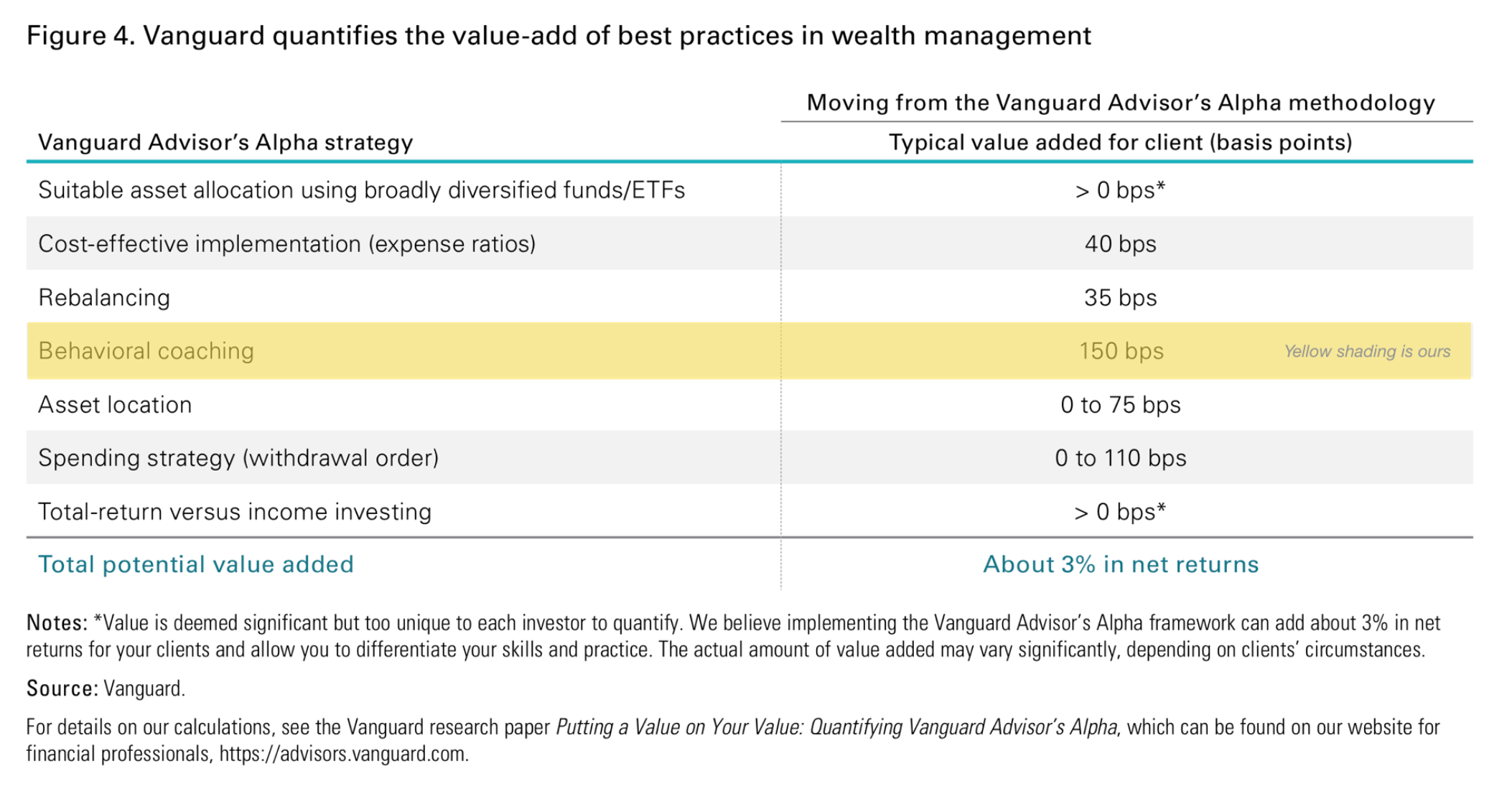
Tim Buckley of Vanguard made headlines last month pointing out his team’s latest research report on advisor value. In it, Vanguard encourages advisors to move their focus from portfolios to people. Of note, the report points to client behavioral coaching as the largest potential contributor to a client’s advice experience – nearly 150 bps, and the only remaining advisor function that is free from the threats of automation.

Behavioral Coaching: a combination of processes, models and methodologies used by coaches to bring about lasting behavioral change on the part of clients.
We'd argue that Understanding is the foundation of Coaching, and in many ways it’s even harder than the coaching itself. Just spend time (a few hours) with these clients, UNDERSTAND THEM IN DEPTH and help them make better decisions. Not so easy.
Understand First, Coach Second
No matter what coaching style you might employ, your foundation of client understanding must be rock solid. For behavioral economists, the ultimate test of our understanding is being able to imitate or replicate the client’s decisions and intent. This is symbolic of being able to walk in their shoes.
Below is a client understanding process, grounded in Behavioral Economics, that focuses on tradeoffs and client preferences. We will explore more in upcoming posts.
Step 1: Explore the Big Tradeoffs in Life
Every decision in life, both large and small, has some combination of these three tradeoffs at play. Explore these areas with your clients and you have the starting point and a framework for your behavioral coaching value add.
- Risk vs. Reward: What Risks am I willing to take for the Rewards available?
- Today vs. Tomorrow: What is enjoyment today worth to me in terms of lack of consumption tomorrow?
- Self vs. Others: How do I value well-being for myself vs. the well-being I might create for others?
Step 2: Measure Client Preferences: Risk Preferences, Time Preferences and Social Preferences
The way clients solve these tradeoffs (whether we know it or not) is by having preferences. Respective to the tradeoffs above:
- Risk Preferences – How we solve Risk vs. Reward tradeoffs inside a decision
- Time Preferences – How we solve spend today vs. spend later dilemmas
- Social Preferences – How we solve tradeoffs between ourselves vs. others
Recent inventions in economics and gamification present us with techniques for precisely measuring these preferences. We call the resulting data an Economic Fingerprint. "Economic" because these preferences are grounded in economic theory and mathematics, and “Fingerprint” because it is unique to each client.
If you can measure a client’s preferences across these domains—in other words, their Economic Fingerprint—you now have a clear view (or "insight") into the client’s thought process and resulting behaviors. And that's the gateway to more effective behavioral coaching.
Step 3: Put It Into Practice: Coaching from Insights
It may seem obvious, but effective coaching requires insights about the client that the client wouldn’t come up with on their own.
Knowing a client's Economic Fingerprint can provide that insight, with very rich texture. For example, consider Retirement. Your client’s preferences toward Retirement planning are a unique combination of risk, time and social preferences.
As a client, my Risk preferences may be such that I really like the feeling of cash under my mattress—in other words, taking no risk at all. And, being happy to just work harder and try to save more now to satisfy this preference. Coach Me.
My Time preferences are such that I must have the new car today and I will have to retire with less to enjoy that new car smell now. Coach Me.
My Social preferences could be that I don’t care to plan for retirement at all, and my plan is that my kids will take care of me – sorry kids. Coach Me
Bring all these together, and you've got the insight to coach this client in a personally meaningful way.
“All coaching is, is taking a player where he can’t take himself.”
– Bill McCartney, Former Head Football Coach at the University of Colorado
To learn more about the behavioral economics and methods sitting behind Economic Fingerprints, visit www.trueprofile.com/the-science. Or to see the methods in action, request a demo.

